Insect hygroreceptor responses to continuous changes in humidity and air pressure
- PMID: 20375249
- PMCID: PMC3206210
- DOI: 10.1152/jn.01043.2009
Insect hygroreceptor responses to continuous changes in humidity and air pressure
Abstract
The most favored model of humidity transduction views the cuticular wall of insect hygroreceptive sensilla as a hygromechanical transducer. Hygroscopic swelling or shrinking alters the geometry of the wall, deforming the dendritic membranes of the moist and dry cells. The small size the sensilla and their position surrounded by elevated structures creates technical difficulties to mechanically stimulate them by direct contact. The present study investigated hygroreceptors on the antennae of the cockroach and the stick insect. Accurately controlled, homogeneous mechanical input was delivered by modulating air pressure. Both the moist and dry cells responded not only to changes in air pressure but also in the opposite direction, as observed during changes in air humidity. The moist cell's excitatory response to increasing humidity and increasing air pressure implies that swelling of the hygroscopic cuticle compresses the dendrites, and the dry cell's excitatory response to decreasing humidity and decreasing air pressure implies that shrinking of the hygroscopic cuticle expands the dendrites. The moist and dry cells of the stick insect are more sensitive to pressure changes than those of the cockroach, but the responses to air pressure are generally weaker than to humidity. Therefore the hygroreceptive sensilla differ in their physical properties and constitutions. Furthermore, the mechanical parameters associated with homogeneous changes in air pressure on the sensillum surface can only partially account for the responses of the moist and dry cells of both species to humidity stimulation.
Figures









Similar articles
-
The evaporative function of cockroach hygroreceptors.PLoS One. 2013;8(1):e53998. doi: 10.1371/journal.pone.0053998. Epub 2013 Jan 16. PLoS One. 2013. PMID: 23342058 Free PMC article.
-
The structure of bimodal chemo-, thermo-, and hygroreceptive sensilla on the antenna of Locusta migratoria.Cell Tissue Res. 1981;215(2):289-308. doi: 10.1007/BF00239116. Cell Tissue Res. 1981. PMID: 7214477
-
Responses of the antennal bimodal hygroreceptor neurons to innocuous and noxious high temperatures in the carabid beetle, Pterostichus oblongopunctatus.J Insect Physiol. 2015 Oct;81:1-13. doi: 10.1016/j.jinsphys.2015.06.010. Epub 2015 Jun 20. J Insect Physiol. 2015. PMID: 26099925
-
Fine structure of olfactory sensilla in myriapods and arachnids.Microsc Res Tech. 1992 Sep 1;22(4):372-91. doi: 10.1002/jemt.1070220406. Microsc Res Tech. 1992. PMID: 1392066 Review.
-
Ions and mucoid substances in sensory organs--microanalytical data from insect sensilla.Symp Soc Exp Biol. 1989;43:131-8. Symp Soc Exp Biol. 1989. PMID: 2701472 Review.
Cited by
-
Weather-dependent microhabitat use by Tetrix tenuicornis (Orthoptera: Tetrigidae).Naturwissenschaften. 2016 Aug;103(7-8):68. doi: 10.1007/s00114-016-1393-9. Epub 2016 Jul 20. Naturwissenschaften. 2016. PMID: 27437707
-
A novel assay reveals hygrotactic behavior in Drosophila.PLoS One. 2015 Mar 4;10(3):e0119162. doi: 10.1371/journal.pone.0119162. eCollection 2015. PLoS One. 2015. PMID: 25738801 Free PMC article.
-
The antennal scape organ of Scutigera coleoptrata (Myriapoda) and a new type of arthropod tip-pore sensilla integrating scolopidial components.Front Zool. 2021 Nov 4;18(1):57. doi: 10.1186/s12983-021-00442-9. Front Zool. 2021. PMID: 34736489 Free PMC article.
-
Morphology and ultrastructure of external sense organs of Drosophila larvae.Elife. 2025 Jun 16;12:RP91155. doi: 10.7554/eLife.91155. Elife. 2025. PMID: 40522083 Free PMC article.
-
Functional fusion of living systems with synthetic electrode interfaces.Beilstein J Nanotechnol. 2016 Feb 26;7:296-301. doi: 10.3762/bjnano.7.27. eCollection 2016. Beilstein J Nanotechnol. 2016. PMID: 26977386 Free PMC article.
References
-
- Altner H, Schaller-Selzer L, Stetter H, Wohlrab I. Poreless sensilla with inflexible socket. Cell Tissue Res. 1983;234:279–307. - PubMed
-
- Altner H, Tichy H, Altner I. Lamellated outer dendritic segments of a sensory cell within a poreless thermo- and hygroreceptive sensillum of the insect Carausius morosus. Cell Tissue Res. 1978;191:287–304. - PubMed
-
- Becker D. Elektrophysiologische Untersuchungen zur Feuchterezeption durch styloconische Sensillen bei Mamestra brassicae L (Lepidoptera, Noctuidae) Univ. Regensburg; 1978. Thesis.
-
- Itoh T, Yokohari F, Tominaga Y. Two types of antennal hygro- and thermoreceptive sensilla of the cricket, Gryllus bimaculatus (De Geer) Zool Science. 1984;1:533–543.
-
- Loftus R. Responses of the antennal cold receptor of Periplaneta americana to rapid temperature changes and to steady temperature. Z Vergl Physiol. 1968;59:413–455.
Publication types
MeSH terms
Grants and funding
LinkOut - more resources
Full Text Sources

